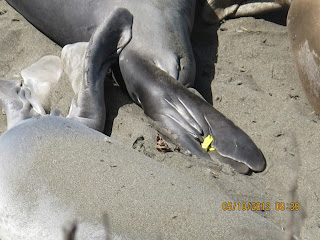There’s always something different to see at the elephant
seal viewpoint. Beachwalker Elizabeth Bettenhausen spotted this marked seal at
Arroyo Laguna beach in April. Her sighting became part of Patrick Robinson’s
research.
Dr. Robinson, UC Año Nuevo Island Reserve Director and UC
Santa Cruz lecturer, has marked hundreds of flipper-tagged animals each year.
The markings make it easier to identify them from a distance, without
disturbing them. Or, incidentally, putting the observer at any risk. Watch how
Dr. Robinson marks the seals in this video.
“We marked this seal up at Ano Nuevo a few months ago and it
appears to have returned home,” he said. “I'll incorporate this sighting in our
database. Many thanks!”
His research is discovering where seals go, and identifying which
seals are on local beaches. This seal is in a general demographic study.
The dyed markings are temporary. They will peel off with her
skin when she molts, which is happening in April and May.
Elephant seals molt their skin annually in the spring. All
other seals molt, but most do so gradually, so it isn’t as noticeable. Molting
seals show pearl gray new skin underneath the tattered old brown skin, peeling
back.
The new skin is already formed beneath the old skin. Blood
gradually stops flowing to the old skin, and it peels off in pieces. Friends of
the Elephant Seals docents have samples of it to show visitors. Visitors are
welcome to touch it, feel its bristly hairs. Some visitors are reluctant, but
most are willing.
Some of the seals have a color-coded tag on their hind
flippers that indicates where they were born. About three quarters of the seals
return to their birth beach. About ten percent of Piedras Blancas seal pups get
a white tag. All colors of tags show up here. The tags are small, only an inch
and a half long, and can’t be seen when the flippers are folded, as they usually
are when the seals are at rest. Look for a seal stretching its flippers to see
a white, red (San Nicolas Island,) yellow (San Miguel Island), pink (Farallones
Islands and Point Reyes), purple (Gorda) or green (Ano Nuevo) tag.
 |
| This seal got two white tags. |
 |
| This yellow tag indicates the seal was born on San Miguel Island. |
Elephant seals are deep divers, spending their days at 500
to 2,000 feet down in the ocean. That makes them difficult for fragile humans
to follow. We’d be crushed at the pressure, more than 60 times the atmosphere
on the surface. Humans experience serious effects at 100 feet, and even
professional free divers don’t go past 400 feet. Digital tracking equipment
opens opportunities that would otherwise be beyond human observation.
Tell a blue-jacketed docent if you observe unusual markings.
Be part of the adventure of elephant seals.
Published in The Cambrian.
